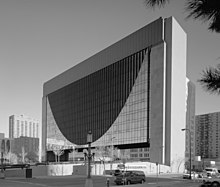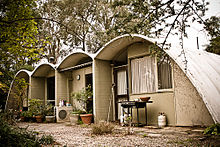

A catenary arch is a type of architectural arch that follows an inverted catenary curve. The catenary curve has been employed in buildings since ancient times. It forms an underlying principle to the overall system of vaults and buttresses in stone vaulted Gothic cathedrals and in Renaissance domes. It is not a parabolic arch, although the non-circumferential curves used in arch designs (parabola, catenary, and weighted catenary) look similar, and match at shallow profiles, so a catenary is often misclassified as a parabola (per Galileo, "the chain fits its parabola almost perfectly").
In history

The 17th-century scientist Robert Hooke wrote: "Ut pendet continuum flexile, sic stabit contiguum rigidum inversum", or, "As hangs a flexible cable so, inverted, stand the touching pieces of an arch."
A note written by Thomas Jefferson in 1788 reads, "I have lately received from Italy a treatise on the equilibrium of arches, by the Abbé Mascheroni. It appears to be a very scientific work. I have not yet had time to engage in it; but I find that the conclusions of his demonstrations are, that every part of the catenary is in perfect equilibrium".
Structural properties
Architecturally, a catenary arch has the ability to withstand the weight of the material from which it is constructed, without collapsing. For an arch of uniform density and thickness, supporting only its own weight, the catenary is the ideal curve.
Catenary arches are strong because they redirect the vertical force of gravity into compression forces pressing along the arch's curve. In a uniformly loaded catenary arch, the line of thrust runs through its center.
This principle has been employed architecturally to create arched structures that follow exactly, and in a visibly apparent way, the form of an inverted catenary. A significant early example of this is the arch of Taq Kasra. The catenary, spun 180 degrees, forms the structure of simple domed building such as the beehive homes of the Dingle Peninsula, Ireland.
The principle of the catenary is also the underlying factor in the much more complex architectural systems of the Medieval and Renaissance architecture. Buildings that have heavy roofs that are arched in shape and deliver a strong outward thrust must comply with the form of the catenary curve in order not to collapse. This does not imply that the arches themselves are catenary in form, but that the total system of walls or buttresses that support the roof or dome contain a catenary curve, which delivers the downward thrust.
In the 15th century Brunelleschi designed the pointed, octagonal, Gothic dome on Florence Cathedral in a manner that utilised the principle of the catenary arch. In the 17th century, Christopher Wren designed the dome of St Paul's Cathedral based directly on a catenary curve. The vaulted roof and buttresses of Kings College Chapel, Cambridge, have been discovered to comply with the formula of the catenary arch.
Examples
The classification of non-circumferential curves in actual arches is hard. González et al. provide an example of (well-studied) Palau Güell, where researchers do not agree on classification of the arches or claim the prominence of parabolic arches, while the accurate measurements show that just two of the 23 arches designed by Gaudi are actually parabolic.
Ancient arches

The curves close in shape to catenary were used in arches of Ramesseum (13th century BC) and Arch of Ctesiphon (6th century AD).
The unfinished Saqqara ostracon has a catenary shape.
Cathedrals and churches

- King’s College Chapel, in Cambridge, England
- St Paul's Dome
- Brunelleschi's Dome
- Casa Batlló has catenary arches
- Casa Mila, in Barcelona, Spain was designed by Antoni Gaudi, who used many catenary arches
- Church of Colònia Güell
Natural arches

Rainbow Natural Bridge in the U.S. state of Utah has a natural catenary shape, possibly produced by weathering in high-stress areas. Kolob Arch and Landscape Arch, also in Utah, have a catenary shape as well.
Human-made arches
The Gateway Arch in the American city of St. Louis (Missouri) is a catenary arch Due to more strength needed at the bottom, the bottom of this arch is wider than the top, so the actual shape is technically a "weighted catenary".
High-rises

Marquette Plaza in Minneapolis used catenary arches.
Kilns
Kilns are often designed with catenary arch cross-section.
Igloos
Further information: Igloo § ConstructionIgloos are designed with a catenary arch cross-section. This shape offers an optimal balance between height and diameter, avoiding the risk of collapsing under the weight of compacted snow.
Other architecture
The inside of Budapest’s Keleti Railway Station forms a catenary arch.
The Nubian ton is a burial vault, of Nubia, For greatest stability, the structure’s cross-section follows a catenary arch.
The beehive homes (clocháns) of Ireland’s Skellig Michael have a cross-section that follows the style of a catenary arch.
Homes


The Rice House has catenary arches.
Hotels
The Icehotel in Sweden employs catenary arches.
Bridges
A catenary bridge has the form of a catenary arch.
One famous example is the An-Lan Bridge, in China.
Monuments

In Iraq, the Taq Kasra has the shape of a catenary arch.
Airports
The roof of Washington Dulles International Airport is a suspended catenary curve.
A catenary steel cable system supports the roof of Denver International Airport.
Train stations
New York City’s Pennsylvania Station has a roof in the form of a catenary arch.
Banks
On the Federal Reserve Bank of Minneapolis, the building has been remodeled, but still visible is the catenary arch suspending the original building.
Mud huts
Cameroon's musgum mud huts have a catenary cross-section.
See also
- Arch bridge
- Catenary
- Gothic arch
- Lancet window
- Mathematics and architecture
- Parabolic arch
- Simple suspension bridge
- Steel catenary riser
References
- Handy, Richard L. (May 2011). "Letter to the Editors: The Perfect Dome". American Scientist. Archived from the original on 2016-04-23. Retrieved 2016-04-17.
- Bradley & Gohnert 2022.
- Osserman 2010, p. 220.
- "The enigma of Robert Hooke". Quantum Frontiers. Institute for Quantum Information and Matter, California Institute of Technology. 31 August 2015.
- Jefferson, Thomas (1830). Memoir, Correspondence, and Miscellanies, from the Papers of Thomas Jefferson, Volume 2. Boston: Gray and Bowen. p. 416.
- "St. Louis Gateway Arch". enchantedlearning.com. Retrieved 27 April 2016.
- "Building an arch that can stand up by itself". strath.ac.uk. Retrieved 27 April 2016.
- "The inverted catenary arch". zonedome.com. Retrieved 27 April 2016.
- "Build an arch that can stand up by itself" (PDF). Archived from the original (PDF) on 2016-04-25.
- Karl Robin Nilsson. "Getting the arch back into architecture" (PDF).
- González, Samper & Herrera 2018, pp. 174, 184.
- Hourihane 2012, p. 130, Catenary.
- "An Ancient Egyptian Catenary Construction Curve". 1926.
- "The British Architect". google.com. 1887. Retrieved 27 April 2016.
- "Maths in a minute: St Paul's dome". maths.org. Retrieved 27 April 2016.
- Nora Hamerman and Claudio Rossi. "Brunelleschi's Dome" (PDF).
- The Secrets of the Florentine Dome: The Secrets of the Florentine Dome, accessdate: January 25, 2017
- "Casa Batlló". Retrieved 2 May 2016.
- "The Catenary Arch". naturalhomes.org. Retrieved 27 April 2016.
- "The Geometry of Antoni Gaudi". slu.edu. Retrieved 27 April 2016.
- "Catenary Method" (PDF).
- "Colònia Güell". barcelonaturisme.com. Retrieved 27 April 2016.
- ^ Handy, Richard L. (Dec 1973). "The Igloo and the Natural Bridge as Ultimate Structures" (PDF). Arctic. 26 (4): 276–281. doi:10.14430/arctic2926. Archived from the original (PDF) on 2016-03-04. Retrieved 2017-01-15.
- Jay H. Wilbur. "The Dimensions of Kolob Arch".
- Cincinnati Cache Collectors. "Landscape Arch".
- "Modern Steel Construction" (PDF).
- Robert Osserman. "How the Gateway arch got its Shape" (PDF).
- "Marquette Plaza Property Information". Archived from the original on 23 June 2016. Retrieved 2 May 2016.
- "Platinum Plaza" (PDF). 2 May 2016. Archived from the original (PDF) on 23 June 2016. Retrieved 2 May 2016.
- Ken Nagakui (1926). "Kiln Building". Archived from the original on 24 June 2016. Retrieved 30 April 2016.
- Dan Cruickshank (2 April 2008). "What house-builders can learn from igloos". Retrieved 1 May 2016.
- "Budapest". Retrieved 8 May 2016.
- "Nubian Ton".
- "Beehive Homes".
- "Rice House".
- "Icehotel - facts". ICEHOTEL. Retrieved 27 April 2016.
- "Suspension Bridge". uoregon.edu. Retrieved 27 April 2016.
- Chris J K Williams. "Taq Kasra" (PDF). Archived from the original (PDF) on 2017-01-04.
- , Jackie Craven. "Dulles Airport". Archived from the original on 2016-05-05.
- "Denver International Airport".
- David W. Dunlap (1926). "Penn Station's 5th Redesign Fails to Charm Some Critics". The New York Times.
- "100 Years of the Ninth District Fed - Federal Reserve Bank of Minneapolis". minneapolisfed.org. Archived from the original on 21 November 2019. Retrieved 27 April 2016.
- "musgum earth architecture". 18 February 2010. Retrieved 2 May 2016.
- Katy Purviance. "Architecture Addiction, The Official Blog of". Archived from the original on 4 January 2017. Retrieved 2 May 2016.
- "Masonry Design". 11 May 2010. Retrieved 23 December 2016.
Sources
- Bradley, R.A.; Gohnert, M. (2022-09-02). "Parametric study of the catenary dome under gravity load". Current Perspectives and New Directions in Mechanics, Modelling and Design of Structural Systems. London: CRC Press. doi:10.1201/9781003348443-130. ISBN 978-1-003-34844-3.
- González, Genaro; Samper, Albert; Herrera, Blas (2018). "Classification by Type of the Arches in Gaudí's Palau Güell". Nexus Network Journal. 20 (1): 173–186. doi:10.1007/s00004-017-0355-7. ISSN 1590-5896.
- Hourihane, C. (2012). "Arch". The Grove Encyclopedia of Medieval Art and Architecture. Vol. 1. Oxford University Press. pp. 129–134. ISBN 978-0-19-539536-5. Retrieved 2024-12-24.
- Osserman, Robert (February 2010). "Mathematics of the Gateway Arch" (PDF). Notices of the American Mathematical Society. 57 (2): 220–229. ISSN 0002-9920.
External links
- The use of the catenary arch in architecture
- Natural arches that are catenary arches
- Twisted Physics reference
- Used in building
- More on the catenary, used in arches
- A few catenary arches
- An experiment
- A youtube, all about catenary arches
- A second youtube
- a youtube on building a catenary arch
- Another youtube